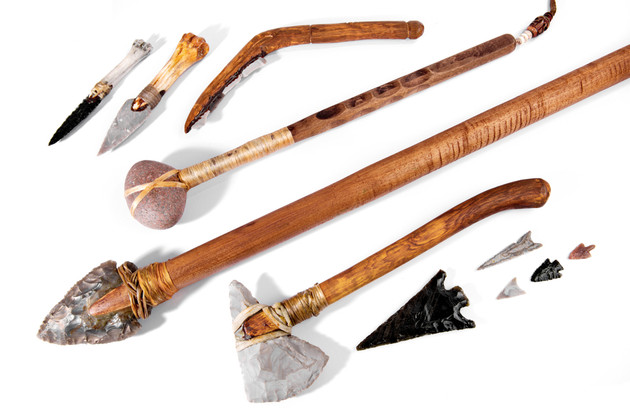Turning Bones Into Weapons
Posted by Sword N Armory on May 12th 2020
For thousands of year’s man has developed weapons for warfare, hunting, tools and decorations for clothing and jewelry from the materials that were accessible at that time. As the technology developed the weapons have also changed with it throughout history.
In 2013 a site in central Alaska was excavated where they found the bones of two small children that dated back 12,000 years ago. They had been buried with ritual objects that dated to around 11,230-11,600 years. The researchers seemed to think that the implements found with them, which consisted of antler rods, projectile points and sharpened stones, were placed there by the family. The antler rods were most probably used as spears or dart shafts and the points were attached to these rods. It was equated to a functional hunter’ tool kit.
Bones were used in place of wood many times for weapons and armor. Other material such as shells, ivory and horn were also used. Bone weapons do not have the hardness therefore creating a fragile quality for weapons and armor.
There are numerous ways in which to obtain bone for weapons or tools. Cannibalistic tribes would leave the bones of their victims to cook on the fire or hung them on a drying rack. By boiling or cooking the bones they will achieve a level of hardness. Animal bones can be found in caves, and put to use. Bones can be used for skirmish weapons in a hand to hand fight. Primitive people created a form of bone armor which consisted of bones and leather or hide of an animal.
However, bone is brittle and it'll fracture. It also won't hold and edge if it's being used for a knife or some type of cutting instrument. If your opponent is of a similar level as you, then you'll be fighting with the same or similar weapons, so if you were to grab a bone from a kill you could probably do just fine.
The fact is that weapons are designed to do specific things. Some will fail or break the weapon. When warriors are trained the thing to take into account is to only use the weapon in whatever is its strongest direction. Where bone is concerned the strong direction is the long direction. This is due to the way these long bones are utilized within the body. The leg bones tend to have to hold up a lot of weight so therefore should be stronger than say a rib bone.
Bone spear points have been found around the world. In Washington State in the 1970’s a mastodon rib bone was found that had a bone spear point embedded in it. It was carbon dated to around 14,000 years old.
At some point in time man learned that you could not depend upon chance to provide him with a weapon, and there just might not be a convenient rock or stone, some sort of wood to use as a club or a piece of bone. They did however learn to carry some type of weapon with him at all times.
In Siberia during an excavation they uncovered weapons for around 35,000 years ago. There were not however any weapons made of wood, bone or stone. The people of this era were hunters of big game and had to have used offensive as well a defensive weapon. The dig did however have bifacially oval knives, flake cores, choppers, end scrapers and two different kinds of burins. The knives, end scrappers and burins were wood and bone working tools and that was taken to mean that they were creating spearheads from wood and bone. The researchers presumed that these weapons have long ago decayed and turned to dust.
The first thought we have when we consider the Native Americans is the bow and arrow. These were used for hunting and in warfare and nearly every Native tribe used one form or another of the bow and arrow. Palo-Indian arrowheads have been discovered in North America and were dated at more than 13,000 years old. They have also discovered arrowheads made by the ancestors of the Native Americans along with the bones of a wooly mammoth and a giant bison, prehistoric animals that are now extinct.
There are still a lot of undiscovered weapons and tools of the prehistoric man which the archeologists will eventually discover so that we may learn more in connection with our ancestors of thousands of years ago.












